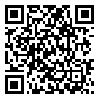Volume 12, Issue 4 (Autumn 2024)
Iran J Health Sci 2024, 12(4): 291-304 |
Back to browse issues page
Ethics code: IR.MAZUMS..REC.1399.8363
Clinical trials code: MAZUMS-8363
Download citation:
BibTeX | RIS | EndNote | Medlars | ProCite | Reference Manager | RefWorks
Send citation to:



BibTeX | RIS | EndNote | Medlars | ProCite | Reference Manager | RefWorks
Send citation to:
Kalteh H, Salarian A, Ramzani S, Yazdani Cherati J, Etemadinezhad S. Assessing the Cognitive Sign Features and Guessability of Laboratory Safety Signs for Pharmacy Students. Iran J Health Sci 2024; 12 (4) :291-304
URL: http://jhs.mazums.ac.ir/article-1-927-en.html
URL: http://jhs.mazums.ac.ir/article-1-927-en.html
Hajiomid Kalteh 

 , Aghigh Salarian
, Aghigh Salarian 

 , Solale Ramzani
, Solale Ramzani 

 , Jamshid Yazdani Cherati
, Jamshid Yazdani Cherati 

 , Siavash Etemadinezhad *
, Siavash Etemadinezhad * 




 , Aghigh Salarian
, Aghigh Salarian 

 , Solale Ramzani
, Solale Ramzani 

 , Jamshid Yazdani Cherati
, Jamshid Yazdani Cherati 

 , Siavash Etemadinezhad *
, Siavash Etemadinezhad * 


Department of Occupational Health Engineering, School of Health, Mazandaran University of Medical Sciences, Sari, Iran. , dr.setemadi@yahoo.com
Abstract: (2336 Views)
Background and Purpose: Correct recognition of hazards in academic labs by using safety signs can prevent injuries in these settings. Although safety signs seem simple, misunderstanding them can put students at risk. Therefore, this research aims to assess the cognitive sign features and guessability of laboratory safety signs for pharmacy students.
Materials and Methods: In this study, the comprehensibility of 22 commonly used safety signs was evaluated by 55 pharmacy students aged 20-30 years from Mazandaran University of Medical Sciences, Iran. Two measures of guessability score and cognitive sign features were used to assess the safety signs. The guessability score was measured by a five-choice answering method, where there were correct, partly correct, and wrong answers. Cognitive sign features (familiarity, concreteness, simplicity, meaningfulness, and semantic closeness) rated from 0 to 100. SPSS software, version 23 was applied for data analysis. Data were analyzed using descriptive statistics, box plots, and the Spearman correlation test. The significance level was set at 0.05.
Results: The lowest guessability score was 1.08% for the “general mandatory action sign”, and the highest score was 100% for the “no smoking” sign. Despite the varying responses, two “general mandatory action” and “disconnect before carrying out maintenance or repair” signs had significantly scattered coefficients of variation. According to the overall scores for cognitive sign features, the simplicity criterion had the highest score (85.73%). All cognitive sign features significantly correlated with guessability scores except for concreteness and familiarity. The highest coefficient was reported between guessability score and semantic closeness (r=0.469, P<0.001).
Conclusion: The lab safety signs without accompanying text or those that are not frequently encountered are difficult to be perceived correctly by pharmacy students.
Materials and Methods: In this study, the comprehensibility of 22 commonly used safety signs was evaluated by 55 pharmacy students aged 20-30 years from Mazandaran University of Medical Sciences, Iran. Two measures of guessability score and cognitive sign features were used to assess the safety signs. The guessability score was measured by a five-choice answering method, where there were correct, partly correct, and wrong answers. Cognitive sign features (familiarity, concreteness, simplicity, meaningfulness, and semantic closeness) rated from 0 to 100. SPSS software, version 23 was applied for data analysis. Data were analyzed using descriptive statistics, box plots, and the Spearman correlation test. The significance level was set at 0.05.
Results: The lowest guessability score was 1.08% for the “general mandatory action sign”, and the highest score was 100% for the “no smoking” sign. Despite the varying responses, two “general mandatory action” and “disconnect before carrying out maintenance or repair” signs had significantly scattered coefficients of variation. According to the overall scores for cognitive sign features, the simplicity criterion had the highest score (85.73%). All cognitive sign features significantly correlated with guessability scores except for concreteness and familiarity. The highest coefficient was reported between guessability score and semantic closeness (r=0.469, P<0.001).
Conclusion: The lab safety signs without accompanying text or those that are not frequently encountered are difficult to be perceived correctly by pharmacy students.
Type of Study: Original Article |
Subject:
Occupational Health
Send email to the article author
| Rights and permissions | |
 |
This work is licensed under a Creative Commons Attribution-NonCommercial 4.0 International License. |






